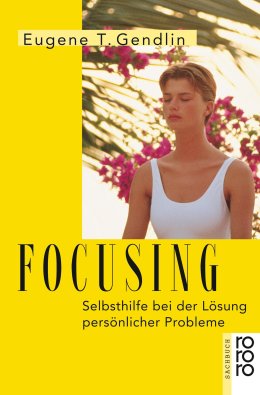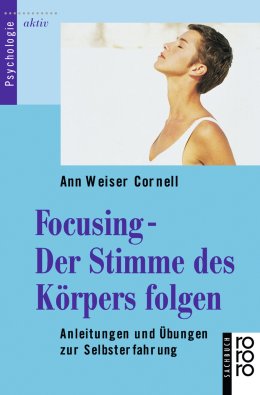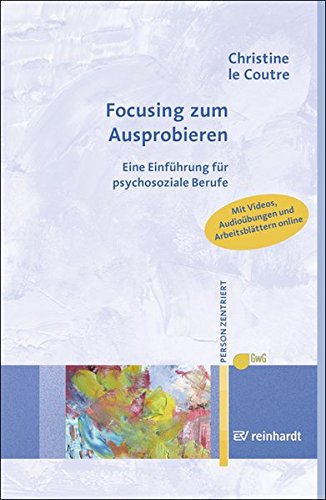Focusing

Focusing was developed by American psychotherapist Eugene T. Gendlin and was first published as a method in his book "Focusing" in 1978. In this book, he summarized his decades of experience. He discovered that people who responded particularly well to psychotherapy and achieved good results often behaved differently in the first sessions than the rest of his treated clients. Gendlin observed that they had a very personal way of talking about themselves. These clients had a special kind of self-awareness: they included physical sensations and did not just talk theoretically about their problems. The Focusing method can be used as a long-term and regularly used strategy. It can also be used as a rapid psychological measure in stressful situations, somewhat like first aid. It can be learned by anyone. The key to the Focusing method: the true expert is the client themselves, not the therapist.
Table of Contents
- What is Focusing?
- How Does Focusing Work?
- Focusing Therapy
- The Six Steps of Focusing
- Focusing Guide – the 6 Steps in Detail
- Duration
- Terms of the Focusing Method
- Focusing Exercise
- Books and Further Literature on the Subject
What is Focusing?
The term "Focusing" comes from the Latin term "focus" and means focal point (or hearth, fireplace). Eugene T. Gendlin had researched the effectiveness of psychotherapy and discovered that less the method of therapy indicated success in treatment, but rather the way in which a client talked about themselves and their situation. These clients were able to focus their attention on their immediate bodily experience while thinking about and talking about their problems. They directly related to the meaning their issue had for them while speaking. Gendlin called this reference and inner involvement "Focusing". Because these clients benefited more from therapy than clients who talked more objectively and abstractly about their problems, Gendlin developed specific training. He wanted to enable everyone to learn Focusing or this attention to their own inner experience. According to him, this could help recognize where one's own life is stuck and constrained, as well as develop a sense of who one wants to become.
How Does Focusing Work?

Focusing is not limited to the perception of feelings or emotions, it is much more than that. It includes feelings, thoughts, and bodily sensations. It is contacting a form of inner, bodily awareness. This awareness is not immediately present, it has to develop first. Often it is initially blurry and unclear. Gendlin called this bodily awareness "Felt Sense". The Felt Sense can arise when one directs their perception to their inner body. It is the bodily perception of a specific problem or situation, or the physically felt meaning of the subject.
Gendlin realized that the Felt Sense deeply influences our lives. It can be used to achieve personal goals. Furthermore, he observed that the Felt Sense gets into motion and changes as soon as one engages with it. Once the Felt Sense changes in a specific situation, the person changes as well.
Focusing is a natural process in itself. It occurs when one turns to their inner experience and directs their attention to where the felt distress actually is in the body. This sets the process in motion, which proceeds in individual steps. It eventually leads to a noticeable psychological change, along with physical relaxation and a sense of relief. Suddenly, the client understands their previously unclear feeling and feels it as well
. Gendlin calls this the "Felt Shift". Once this happens, it can be assumed that Focusing has taken place. In many successful psychotherapy sessions, this process usually occurs unconsciously.
Focusing Therapy
Focusing alone is not psychotherapy. However, it can be used as a complement and is an excellent foundation for further action. What comes to light in the Focusing process can be further processed through additional therapy methods or through coaching. Gendlin himself sees Focusing therapy more as a meta-model for therapy, into which everything that helps people can be integrated, making it cross-disciplinary. For example, various Focusing exercises, sometimes in modified form, can also be found in other therapy or coaching approaches. They are used in addition to bodywork or yoga, serve as perception or mindfulness exercises, or resemble NLP approaches (e.g., VAKOG trance, reframing, positive intention, etc.).
The Six Steps of Focusing
The Focusing process consists of six steps or movements that can be learned. When these steps are successfully executed, a "Felt Shift" occurs in the body, a physical change. After that, the client perceives the worked-on issue differently. With each shift, the nature of the problem changes.
The 6 steps of Focusing are:
- Create Space
- Invite a Felt Sense
- Describe the Felt Sense: Find a “Handle”
- Compare
- Ask
- Accept and Protect
Focusing Guide – the 6 Steps in Detail:
Create Space
Become very quiet and relax for a moment. Direct your attention into your body, into the belly or chest area. Pay attention to what is happening there as you ask yourself how your life is going or what is currently most important to you. Let the answer come from the body. Mentally take a step back and say yes to the feeling. Create a small space between you and this something. Ask yourself again what else you feel and wait for the answer. It may be that current issues or problems arise here that are currently occupying you. You can pretend to push these aside like furniture or boxes to create this space.Invite a Felt Sense
Choose one of the emerged topics. Mentally take a step back and feel all aspects of this topic / this problem simultaneously. Pay attention to the place in your body where you usually feel emotions and observe what feeling the problem as a whole evokes in you. How does it feel? Let it affect you. Do not be impatient if it is initially unclear and formless.Describe the Felt Sense: Find a “Handle”
What kind of unclear Felt Sense is this? What word, what image, what sentence arises from it? It can be a term like "criticism," an adjective like "abandoned," "heavy," as well as a sentence or image. Everything is possible. Stay in touch with the Felt Sense until words or images come that fit exactly. This is the "handle" you have found as soon as the word/image feels right. Often it is a word that initially does not say anything about the problem, but it gives you a starting point to grasp the issue.Compare
Switch between the word/image and the Felt Sense back and forth. Pay attention to how both fit well together, e.g., a physical signal that you have found the right word for it. You have to bring both to mind, the Felt Sense and the word. As soon as the Felt Sense changes, the word must also change until it exactly matches the quality of the Felt Sense. For example, maybe you initially found the term "abandoned." Feel whether it really fits, feel a resonance or whether another word expresses more clearly what is currently there.Ask
Ask yourself why your problem triggers this specific feeling. Make sure you feel the Felt Sense again. Ask yourself, for example, "What makes the whole problem feel so abandoned / so heavy?" Use the term you found in Step 3. Or ask yourself "what is in this feeling?" If you get an answer without a change in the Felt Sense, a "Shift," let the answer pass and redirect your attention back into the body. Search for the Felt Sense again and ask the question again until the answer comes with a physical relief, with a Shift. In other words, you will feel it once you have found the right answer.Accept and Protect
Accept everything that comes with a Shift in a friendly and benevolent attitude and let it affect you for a while. Even if it is only a slight change / relief. It is one small shift among several that will surely come. Pause for a moment before continuing.
With some practice, the steps no longer need to be performed separately but in a single, fluid sequence.
Duration
A Focusing process can take approximately 30 - 60 minutes. Afterwards, it makes sense to reflect on whether another process should be carried out immediately or whether you would prefer to continue working on the issue on another day. Experienced Focusers (= users of Focusing) can also conduct shorter processes in between, for example, to make waiting times meaningful.
Terms of the Focusing Method
Felt Sense
The term cannot be adequately translated into German, and Gendlin did not intend to do so. He had invented Felt Sense as a neologism because there was no other comprehensive description for what constitutes this overall feeling. It refers to the indistinct, physical experience from which images, feelings, and words emerge, simply everything related to the topic. These can also be meanings, experiences, and values. Gendlin sometimes synonymously referred to the Felt Sense as "soft underbelly." For example, imagine a positive word like "sun" or "vacation," let it literally melt on your tongue and slide your feeling towards the lower abdomen. Then this becomes palpable.
Felt Shift
The Felt Shift is the change of the Felt Sense, it occurs during a Focusing process and denotes a felt physical relief, as if a weight is lifted off the client's chest. It is accompanied by a deeper understanding of a previously unclear feeling; thus, the client has a new and liberating insight. Not only in problems but also in the creative process, the appearance of a Felt Shift leads to new insights. Therefore, Focusing can also be used in the field of creativity.
Body Shift
The Body Shift occurs when a profound change is triggered by the Focusing process. It is a specific, physical feeling of change, an unmistakable physical experience. Once experienced, it will always be recognized. This allows someone to judge for themselves whether a change has occurred or not. A Body Shift is characterized by the fact that the client is suddenly much closer to solving a problem than perhaps before in multiple sessions. After each new Body Shift, the problem / issue looks completely different again. Therefore, it does not make sense to address the initially mentioned issue again at this point, as it now appears differently.
Sometimes, Felt Shift and Body Shift are used synonymously in some literature or not clearly distinguished from each other. Often only Shift is mentioned. Felt Shift is frequently described as a noticeable, albeit sometimes small, change, and Body Shift as a fundamental realization that a change has occurred.
Focusing Exercise
Create your inner space - the Good Place
This exercise is about creating an inner space and finding a "Good Place". This is the starting point for any kind of problem-solving or creative process; it helps to create distance when we are stuck or deeply entrenched in a problem.
- First, find a good place in your body. Focus your attention on your body, away from your surroundings, and also away from your thoughts.
- Feel where in your body something feels pleasant. This can be in unusual places, and this place can be smaller or even larger than you expect. Ask yourself, "where does it feel comfortable?" Or: "where in my body do I feel safe?"
- Sometimes you know right away where this place is. And if you can't find this place right away, be patient with yourself and mentally glide from your feet upwards to your head. You will find this place.
- Once you have found the good place in your body, pause for a moment. Enjoy the feeling, let yourself fall into it. What is the most pleasant thing about it?
- Let your breath flow there and pay attention to what arises. Perhaps joy, calmness, serenity, or pure joy of life... or something completely different.
- You can inwardly say to yourself "this is as pleasant as..." - and wait for what (characteristic) word, what image, or perhaps what sound emerges.
- Enjoy and linger for a few moments in this good place and the feeling, your body sensations, and the inner images / sounds.
- Perhaps the feeling also spreads to other parts of your body. Enjoy that too.
- Finish the exercise at your own pace.
Books and further literature on the subject:
Read More:





